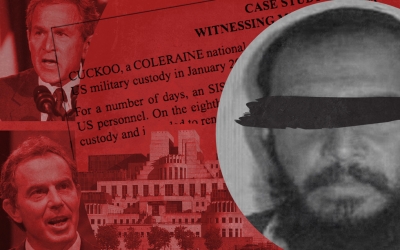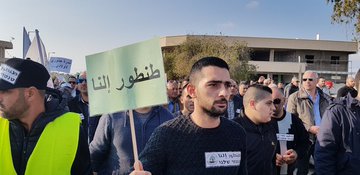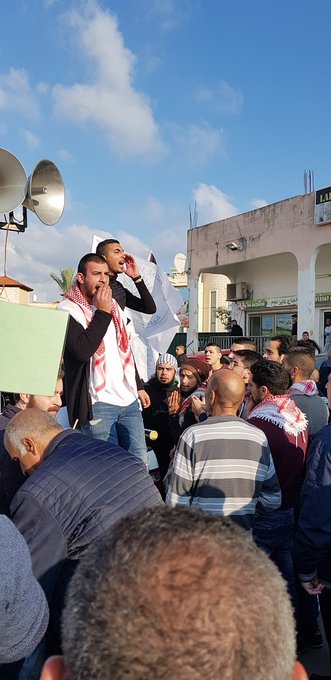A Brief Colonial History Of Ceylon(SriLanka)
Sri Lanka: One Island Two Nations
A Brief Colonial History Of Ceylon(SriLanka)
Sri Lanka: One Island Two Nations
(Full Story)
Search This Blog
Back to 500BC.
==========================
Thiranjala Weerasinghe sj.- One Island Two Nations
?????????????????????????????????????????????????Thursday, February 28, 2019
Israel stops parents joining seriously ill children during treatment

Having a parent at a child’s side is hugely important during convalescence. (
Mahmoud AjourAPA images) Sarah Algherbawi -26 February 2019
Sarah Algherbawi -26 February 2019
Ola al-Waheidi acted quickly when she heard that her 9-year-old daughter Mais had leukemia.
Within a few days of learning about the diagnosis in early December, Ola
had undertaken the paperwork required for Mais to receive medical
treatment outside Gaza. Yet Ola’s efficiency proved no match for
Israel’s cruel bureaucracy.
Ola was soon informed that she may not accompany her daughter through
Erez, the military checkpoint separating Gaza and Israel. Mais would
have to travel without her parents for treatment.
The family then had to give the Israeli military various names,
requesting that someone on the list should accompany Mais. Israel
rejected most of the suggestions, before deciding that Balqis
al-Waheidi, a 72-year-old distant relative with diabetes and rheumatism,
may travel with the child.
Mais was granted permission to travel on 10 December. When they reached
Erez that day, Ola had still not told her daughter about the
arrangements.
“I didn’t know how to tell her that I wouldn’t be with her,” said Ola.
“She was holding my hand the whole way, telling me to not leave her.”
“Heart torn apart”
Once she had gone through the required procedures, Ola spoke to Mais, who was in an ambulance.
Ola said that she was would be back shortly with a bottle of water. Ola
then called their relative Balqis over, asked the woman to take care of
Mais and walked away. Mais had not known Balqis before this trip.
“I watched her [Mais] from a short distance and she had already started
to cry,” said Ola. “My heart was torn apart at that moment.”
Mais was brought to Beit Jala Hospital near Bethlehem in the occupied West Bank.
Muhammad al-Jarusha, who heads the hospital’s department for pediatric cancer, said that Mais was “sad and bored.”
“Mais needed her mother to be with her,” he added.
Because her immunity system has been compromised, Mais has to be kept in
isolation at the hospital so that the risk of infection can be
minimized. She underwent a 33-day chemotherapy program.
During convalescence, it is vital that a patient’s morale is as high as
possible. The forced absence of Mais’ mother had a “negative effect” on
the child’s health at a crucial time, al-Jarusha said.
Ola grew increasingly distressed as she thought of how “my daughter is
dying slowly and I can’t do anything, even be with her,” she said.
After Ola gave details of her family’s plight to a number of human rights organizations, she was eventually allowed join Mais.
“Humiliating”
On the morning of 31 December, Ola was contacted by an Israeli soldier
and summoned to Erez. She hurriedly packed a bag and went directly to
the checkpoint.
She was kept waiting seven hours, without being provided with any information until a female soldier inspected her.
“I was made to take off most of my clothes and searched for 45 minutes,”
Ola said. “It was very humiliating but I didn’t have any choice. I
wanted to reach Mais, whatever it took.”
Mais is still in hospital. “When I saw Mais, it was like we both came
back to life,” said Ola. “We will fight her illness together.”
Mais is one of many children for whom treatment outside Gaza was
essential. On average 58 percent of medicines for leukemia and other
types of cancer were unavailable in Gaza during 2018.
Throughout last year, more than 1,800 patients were stopped from traveling through Erez, compared to 700 for 2017.
The ordeal faced by Ola and Mais actually took place at a time when
there was a slight easing of the movement restrictions placed on Gaza’s
inhabitants.
Almost 3,000 patients and people accompanying them were permitted to
travel through Erez in December. That represented a 21 percent increase
on the average previously recorded for 2018, according to United
Nations data.
Yet even when official statistics indicate that improvements have occurred, the siege on Gaza still causes immense suffering.
It is not uncommon for Israel to deny a parent a travel permit when their child needs treatment.
Mohammad Abu Salmiyeh, head of al-Rantisi Hospital in Gaza City, argued that Israel’s practices can worsen a child’s anxiety.
“Children don’t feel comfortable if they are accompanied with elderly
people,” Abu Salmiyeh said. “Children can’t talk to them about their
feelings, about their fear of death or the implications of chemotherapy.
Having their mothers present would reduce the stress which these
children suffer from.”
According to Abu Salmiyeh, approximately 50 children from Gaza are being
treated for cancer in Jerusalem and Beit Jala, without their parents
being present.
About 350 children from Gaza have to visit Jerusalem’s hospitals for
chemotherapy or radiotherapy. The children are usually accompanied by
distant relatives on their journeys.
“I miss my family”
Since April last year, 14-year-old Musab al-Daya has traveled from Gaza
to Haifa, a city in Israel, on at least five occasions so that he could
be treated for lung cancer. Musab’s parents were not allowed to
accompany him even once.
Even though Musab’s grandparents are both older than 50, Israel also
forbade them from joining him, giving “security” as a reason. The only
chaperone deemed acceptable by Israel was Muayad Hillis, 70, a neighbor
of Musab’s family in the Shujaiya district of Gaza City.
“At the beginning, I agreed to go with Musab on his journey for
treatment,” said Hillis. “But I found it very tough. I’m not healthy
enough to take care of him. I wasn’t able to travel with him every
time.”
Hillis was too unwell to travel with Musab on his third trip outside
Gaza. The family contacted the Israeli authorities, suggesting
substitutes for Hillis. But the suggestions were rejected, so Musab had
to travel alone.
“I hope my mom can come with me – if only once,” said Musab. “I miss my
family a lot, especially at nighttime. No one is as kind to me as my
parents.”
Six-year-old Muhammad al-Baqa has stomach cancer. He also has a rare condition which means he needs help going to the bathroom.
Applications made by both of Muhammad’s parents to join him while
receiving treatment outside Gaza have been turned down. Israel has
decided that the only person who may accompany him is Muhammad’s
grand-aunt, who is aged 74.
The al-Baqa family did its best to explain to the Israeli authorities
that Muhammad must have a parent with him constantly. But Israel refused
to budge. The parents found the experience so frustrating that they
decided against sending Muhammad outside Gaza.
“My aunt is very old and she can’t deal with Muhammad’s condition,” said
the boy’s father. “He needs special care. If his mother cannot travel
with him, we would prefer to see him die with us beside him than to
leave him alone.”
Sarah Algherbawi is a freelance writer and translator from Gaza.
UK spy agency under pressure to open up over support for CIA torture programme
GCHQ's support of the CIA post-9/11 is becoming clearer, but MEE understands plans for a new inquiry are being resisted The brother of then-detained Amanatullah Ali holds up his identity card in Afghanistan in 2013 (AFP)
The brother of then-detained Amanatullah Ali holds up his identity card in Afghanistan in 2013 (AFP) The
role the UK’s GCHQ surveillance agency played in supporting the CIA’s
post-9/11 kidnap and torture programme is finally becoming clear,
fuelling calls for a judge-led inquiry into British involvement in
rendition operations.
The
role the UK’s GCHQ surveillance agency played in supporting the CIA’s
post-9/11 kidnap and torture programme is finally becoming clear,
fuelling calls for a judge-led inquiry into British involvement in
rendition operations.For more than a decade, GCHQ, which collects intelligence by monitoring communications, has claimed that it had a clean pair of hands, repeatedly denying that it had assisted the CIA.
The agency’s claim that it had “never knowingly provided support to a US rendition operation” was fully accepted by the UK Parliament’s oversight body, the Intelligence and Security Committee (ISC).
However, the committee has now unearthed a number of examples of GCHQ’s intelligence being used to locate and detain terrorism suspects who were subsequently rendered and tortured.
The committee has also found that the agency provided intelligence to assist the interrogation of terrorism suspects held at CIA black sites.
MPs and peers who are members of Parliament’s All Party Parliamentary Group on Extraordinary Rendition say the discoveries underline the need for an inquiry.
The government said last July that it would announce within 60 days whether it would convene a judge-led inquiry, but has not done so.
Ken Clarke, the former home secretary and justice secretary who chairs the group, says that the delay raises suspicions that more is being concealed.
Inquiry campaign disrupted by Brexit
Middle East Eye has learnt that a number of senior UK parliamentarians, including Clarke, are understood to be planning a fresh campaign aimed at persuading the government to convene an inquiry.But they are waiting until the country’s politics are no longer fully consumed with the problems caused by Brexit – the UK’s departure from the European Union.
Under its current chair Dominic Grieve, a former attorney general, the ISC appears to have lost patience with GCHQ’s position: that it cannot be held responsible for rendition operations, on the grounds that it is unaware of the way in which its intelligence is used once it has been passed on to other agencies or countries.
In a damning report published last year, the committee said that it could no longer accept GCHQ’s claim that its role in rendition and the mistreatment of detainees was at worst peripheral, not least because “it is by far the largest sharer of material with the US”.
It added that the agency’s attempts to distance itself from the abuses that its operations have enabled was worrying.
“GCHQ was in fact aware of the risks of large-scale sharing of information with the US but regarded it as neither practical, desirable nor necessary to second guess how that material might be used,” the committee said.
“That GCHQ regarded the treatment of any individual whose detention it had enabled as being beyond its knowledge and therefore not its business, is not – in our opinion – a valid excuse.”
The committee’s findings pose a serious challenge to GCHQ, an agency whose operations appear at times to be inextricably linked, through routine intelligence sharing, with those of its US partner, the National Security Agency (NSA).
It is unclear whether intelligence shared with the NSA may enable the future kidnap and mistreatment of individuals. American president Donald Trump expressed enthusiasm for torture while on the campaign trail, although he has remained silent on the matter since election.
Rendition victims tracked by GCHQ
MEE has identified two rendition victims who were captured by UK forces in Iraq after being tracked and located by GCHQ.Both men were immediately handed to US troops and rendered to Afghanistan, where they spent 10 years detained without trial. On eventual release, both said they had been tortured.
They are both said by the British government to have been members of Lashkar-e-Taiba, a Pakistani militant group with links to al-Qaeda.
Drawing upon military sources, a BBC journalist, Mark Urban, has written that the raid followed a British intelligence and special forces enterprise code-named Operation Aston.
One British soldier was wounded during the raid and two occupants of the house were killed.
Within hours, Ali and Rahmatullah were handed over to US forces and were later flown to the notorious US military prison at Bagram, north of Kabul.
The British government was made almost immediately aware of the location at which they were being held, but made no representations over their treatment until 2009.
Investigations by the legal non-governmental organisation Reprieve found that by that time,
Rahmatullah was described by fellow prisoners as being in “catastrophic mental and physical shape” as a result of his ill-treatment.
Both men were released without charge in 2014.
Lawyers representing the two men are already suing the British government for damages as a consequence of the way in which the British military handed them over to the US after capture.
Details of their subsequent rendition and detention have been confirmed in court judgements.
On examining documents relating to other operations, the ISC also discovered evidence of GCHQ providing intelligence relating to the location of about four other individuals prior to their detention and rendition.
In a further case, the agency provided information that was used to enable an arrest and probably a rendition.
Direct 'support' for operations
The ISC also says it found evidence of direct links between GCHQ intelligence sharing and US rendition operations.It discovered that in April 2006, for example, GCHQ’s senior legal adviser had queried an item in an annual report compiled by one of the agency’s operational teams, which was entitled “Support to RENDITION operations”.
This was seven months before GCHQ’s then director, Sir David Pepper, told the ISC that the agency had “never knowingly” supported rendition operations. The committee was also told that the agency had scoured its records as far back as 1995.
The following year, in a report that is now widely seen as discredited, the committee cleared the UK’s intelligence agencies of involvement in rendition.
It concluded that GCHQ “has played no role in any US renditions” and added that its legal safeguards “provide a high level of confidence that their material has not been used for such operations”.
MEE contacted Pepper, who is now the chair of the government’s Defence Science and Technology Laboratory, but he declined to comment.
In its most recent report on rendition, the ISC also criticised GCHQ for passing on intelligence about Khalid Sheikh Mohammed, the alleged architect of the 9/11 attacks, despite knowing that he was being held in secret CIA detention and was at risk of being mistreated.
A US Senate committee investigation has found that Mohammed was already being subjected to waterboarding by March 2003, when GCHQ passed on its intelligence. According to CIA records, he was subjected to the torture technique at least 183 times.
Responding to questions from MEE, GCHQ declined to say why the committee that provides parliamentary oversight of its activities had not been informed earlier about the existence of the internal report on its support for rendition operations.
The agency also declined to explain why the ISC had previously been allowed to publish a misleading report. Nor would it say whether it was continuing to withhold information from the committee about its involvement in rendition operations.
In a one-sentence statement, the agency said: “We won’t be commenting on this, however the government will formally respond to the [ISC] report in due course.”
The government’s response did not address the way in which the committee had apparently been previously misled.
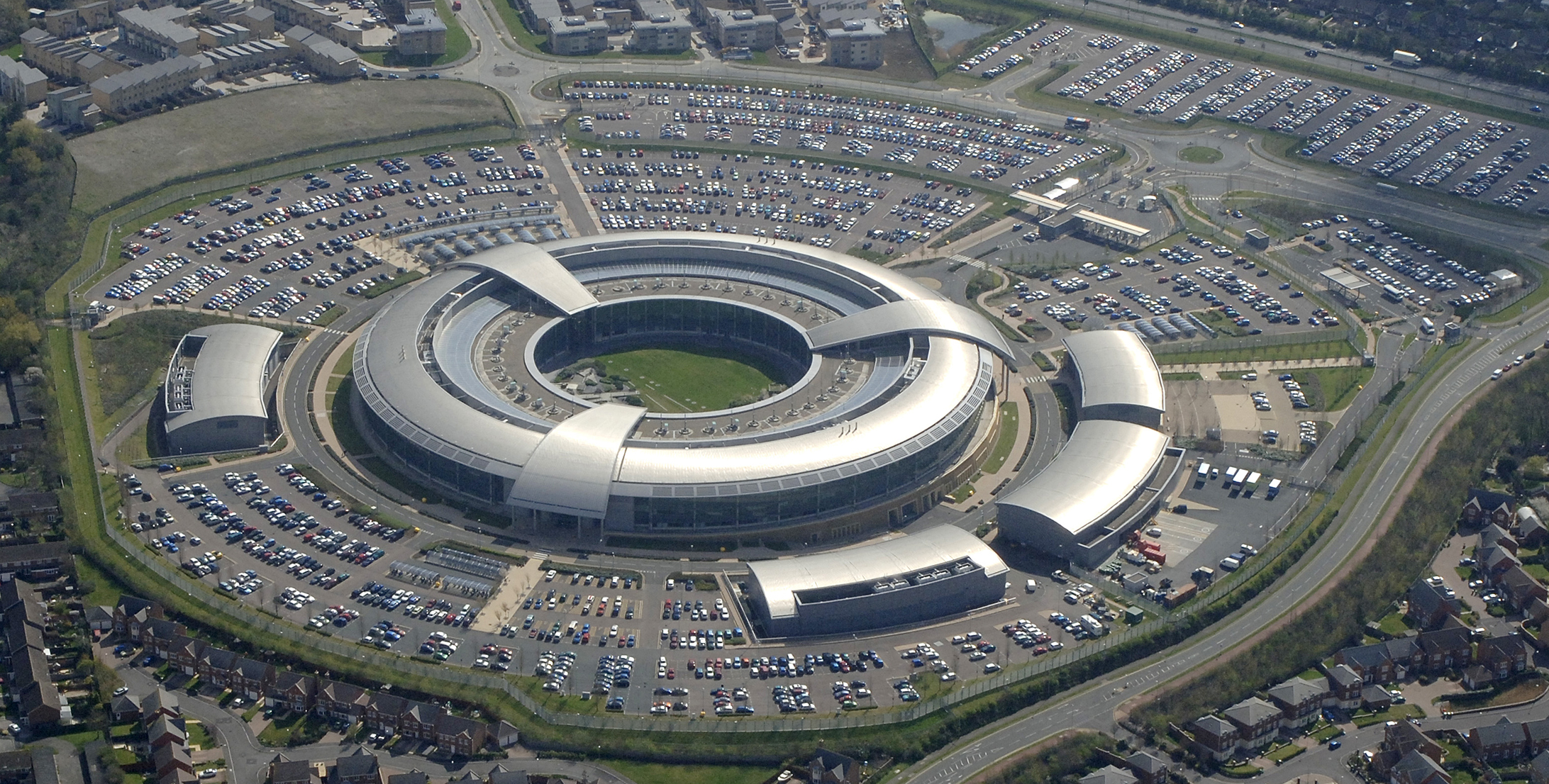
It added that the agency’s operations are now being overseen by the newly-created Investigatory Powers Commissioner’s Office.
Even when conducting the investigation which unearthed evidence of GCHC’s involvement in rendition operations, the ISC says its hands were partly tied.
Its committee’s members - all members of Parliament or peers sitting in the House of Lords - complained that their inquiry was brought to a premature end.
They also complained that they were not able to interview government ministers who were responsible for those agencies, or the agencies’ staffs, who could have shed light on actions on the ground.
Following the UK’s 2010 general election, the Conservative-Liberal Democrat coalition government established a judge-led inquiry into the country’s role in post-9/11 human rights abuses.
That inquiry was shelved in January 2012, however, because of a parallel police investigation into the involvement of the UK’s intelligence agencies in the mistreatment of detainees. The police investigation did not result in any criminal charges being brought.
The British government says it has not decided whether to reinstate any form of further investigation. A spokesperson said: “These are extremely important issues and the government is carefully considering the calls for another judge-led inquiry.”
This article is available in French on Middle East Eye French edition.
Here’s My Super-Abridged Green New Deal


KEVIN DRUMFEBRUARY 24, 2019
Let’s noodle some more about climate change today. On Thursday I regaled you with my abridged Green New Deal. It’s still fine, but I think it can be abridged even more. Bear with me here.
First off, I want to acknowledge that for all the infighting in liberal
circles, the real problem is that full-scale climate denialism has taken
over the Republican Party. This is what’s keeping us from making
serious inroads into carbon emissions. In Europe, by contrast, there is
no equivalent to the Republican Party. Nobody denies that climate change
is real, and there’s no monolithic political opposition to doing
something about it. As a result, over the past two decades Europe has
been far more successful at reducing carbon emissions than the United
States:
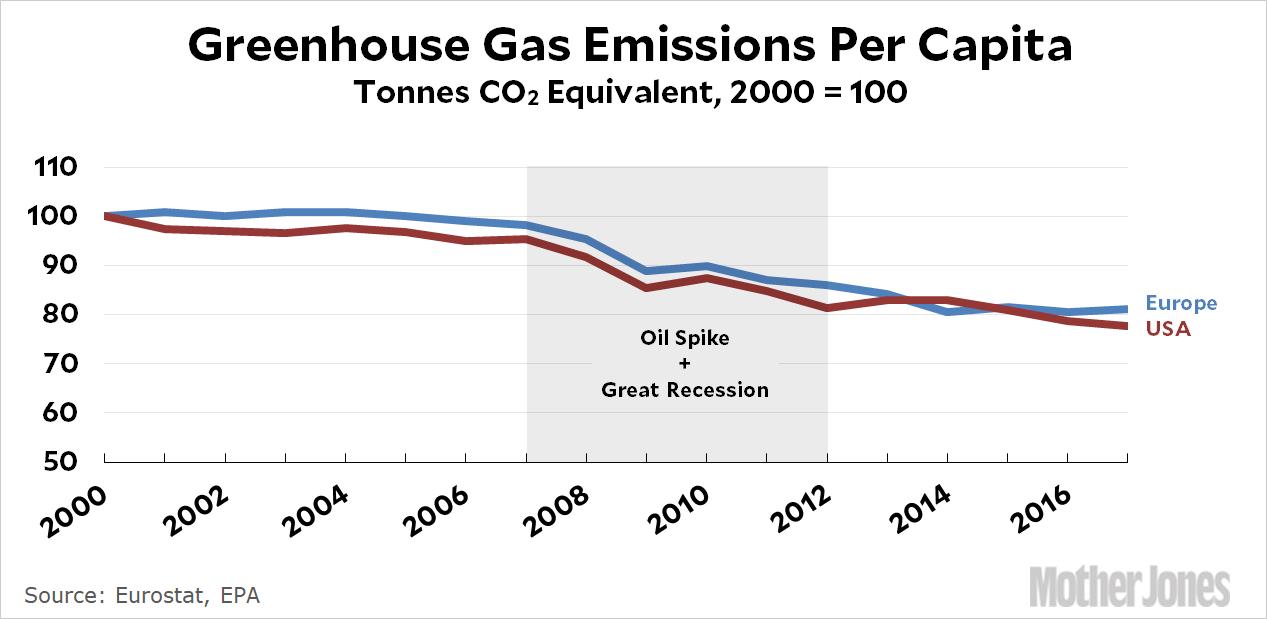
Wait. What’s going on here? In fact, the United States has reduced per-capita carbon emissions slightly more than
Europe, and neither one has managed much reduction at all except when
they’re forced to.¹ Nearly all of the reduction since 2000 came during
the five-year period when oil prices spiked and the Great Recession
killed off economic activity.
In other words, it doesn’t seem as if either the Republican Party or
America’s dysfunctional politics is really the problem. So what is? It
must be something common to both Europe and the US, and the obvious
answer is that we all live in democracies. Roughly speaking, our
governments do what the public wants, and the public doesn’t have much
interest in reducing carbon emissions. Oh, we say we
do, and we’ll support minor things like ETS or CAFE that have a barely
noticeable effect on us. We’ll support solar power—if it produces
electricity nearly as cheaply as coal. We’ll all buy electric cars—but
only when the price comes down and the batteries get better. We’ll check
out the energy star rating the next time we buy a new refrigerator. And
that’s about it.
As for the rest of the world, I won’t even show you the chart. It’s too
depressing. Outside of Europe and the US, carbon emissions are just
going steadily up, up, up. Even the Great Recession barely made a dent.
For the world as a whole, carbon emissions have increased more than 20
percent in the past two decades as poor countries try to catch up to the
living standards of the West.
This is one reason I don’t really care one way or the other about the Green New Deal. Here is how Dave Roberts describes it:
The GND resolution is not a policy or a series of policies. It is a set of goals, aspirations, and principles. It purposefully puts the vision up front and leaves the policymaking for later.
Precisely. It’s just a bunch of goals: “net zero” greenhouse emissions
and 100 percent renewable power via a “10-year mobilization”; a 40-60
percent reduction in global carbon emissions by 2030; “millions” of new
green jobs; etc. These are familiar goals. We all know them and we all
support them—but only as long as nobody is rude enough to talk about
what it would take to actually meet these goals. The GND certainly
doesn’t. That’s because the folks who wrote it know perfectly well what
would happen if it did: it would die instantly.
None of what I’m saying should be even slightly controversial. Outside
of war, I can’t think of an example in all of human history where a
large polity—let alone the entire world—willingly made significant
sacrifices in service of a fuzzy, uncertain hazard that’s decades away.
We are overclocked hairless apes who are simply not designed to think
that way. Why would anyone deny this?
This, then, circles back to what I was saying a couple of days ago: A
climate plan that requires significant sacrifice might work on planet
Vulcan, but not on planet Earth. Assuming otherwise is nonserious. We
need a plan that will work with only homo sapiens to
carry it out, and that means a plan that takes into account human
selfishness and shortsightedness. It means a plan that will appeal to
China and India and Brazil and the rest of the world. It means a plan
that will somehow reduce atmospheric carbon a lot even while most of us
sit around fat, dumb, and happy.
The only such plan I can think of is one that increases global R&D
spending on climate mitigation by, oh, 10x or so. Maybe 20x if it’s
feasible. This money would be spent on developing new sources of clean
energy and energy storage; reducing the price of current sources of
clean energy; figuring out ways to remove carbon from the atmosphere;
and pretty much anything else that seems remotely useful. The fruits of
this research would be turned over to the private sector for free, and
they would then compete to sell it all over the globe. This would harness human
selfishness instead of fighting it. It’s not guaranteed to work, but
unlike the GND and similar manifestos, at least it’s not guaranteed to
fail.
POSTSCRIPT: Just
to make something absolutely clear, I’m not in any way opposed to
taking additional steps to address climate change. In fact, I’m all in
favor of trying to scare the hell out of people about just how bad
climate change is likely to be. I think the goals of the GND are great.
I’m all in favor of ETS and CAFE and the Paris Accords. They don’t
accomplish a lot, but they accomplish something,
and every little bit helps. I just wouldn’t count on the public ever
supporting strong enough versions of this stuff to prevent a
catastrophic future.
¹This chart shows relative declines, but Europe’s emissions were far
lower than the US at the start and are still far lower today in absolute
terms. However, almost none of this has to do with policies aimed at
climate change, which are fairly recent. Europe’s per-capita emissions
have been lower all along because (a) the modern EU contains a lot of
fairly poor countries which have low GDPs and therefore low carbon
emissions, (b) even rich European countries generally have lower GDPs
than the US, and (c) automobile usage is lower thanks to big taxes on
gasoline. Those taxes, and the European devotion to small cars, were a
result of postwar policies designed to reduce gasoline use decades
before anyone had ever uttered the words climate change.
The west must not abandon Crimea and Ukraine to Russian aggression
We condemn Russia’s illegal occupation, which continues to jeopardise international peace five years after it began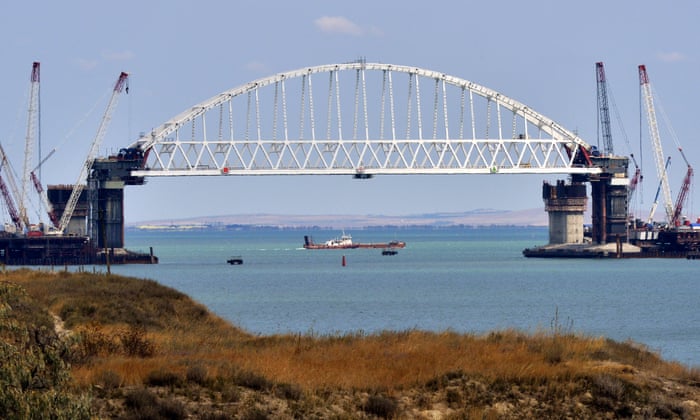 ‘The
construction of the Kerch bridge by Russia is another violation of
Ukraine’s sovereignty and territorial integrity.’ The rail bridge in
2017. Photograph: Lev Fedoseyev/Tass
‘The
construction of the Kerch bridge by Russia is another violation of
Ukraine’s sovereignty and territorial integrity.’ The rail bridge in
2017. Photograph: Lev Fedoseyev/TassJeremy Hunt, Pavlo Klimkinand nine other foreign ministers-
 Five
years ago, Russia gravely challenged the idea of a peaceful and free
Europe. With its aggression against Ukraine and the illegal annexation of Crimea,
Russia openly demonstrated its contempt for the principles of
international law, and presented a serious threat to European security.
Five
years ago, Russia gravely challenged the idea of a peaceful and free
Europe. With its aggression against Ukraine and the illegal annexation of Crimea,
Russia openly demonstrated its contempt for the principles of
international law, and presented a serious threat to European security.Today, the people of Ukraine are more united than ever in their support for their country’s European orientation. Ukraine still has many demanding tasks and reforms to implement, but impressive progress has been made despite ongoing Russian aggression. Ukraine of today is profoundly different from Ukraine pre-2014, and has never before been so close to Europe and European values. By contrast, Crimea under Russian occupation is moving backwards. The people living there are ever more isolated, and the situation with respect to human rights and socio-economic conditions continues to deteriorate.
The illegal annexation of Crimea – an act condemned by the international community – has jeopardised the international rules-based system. The illegitimate “referendum” in Crimea on 16 March 2014 was judged illegal and invalid by the international community. During these past five years that community has called, in the strongest terms, for Ukraine’s territorial integrity to be restored. Sanctions and the non-recognition policy pursued by the EU, Nato and G7 member states reflect our common efforts, and our refusal to accept that the illegal occupation of any territory of a sovereign country can become the norm in the 21st century.
The United Nations Human Rights Monitoring Mission and other international organisations have reported grave human rights violations in Crimea against the Crimean Tatar ethnic minority, ethnic Ukrainians, the non-Russian orthodox religious minorities and civil society activists. Arbitrary arrests and detentions, enforced disappearances, ill treatment and torture and at least one extrajudicial execution have been documented. A large number of political prisoners and detainees awaiting trial have been transferred from Crimea to the Russian Federation, despite the fact that this practice is strictly prohibited by international humanitarian law.
One of the most poignant cases is the arrest and trial of the Ukrainian filmmaker, Oleg Sentsov, last year’s recipient of the European parliament’s Sakharov Prize for Freedom of Thought. Through his courage and determination, by putting his life in danger, Sentsov has become a symbol of struggle for the release of political prisoners held in Russia and around the world.
Last year there were increased tensions in and around the Sea of Azov. The construction of the Kerch bridge by Russia is not only another violation of Ukraine’s sovereignty and territorial integrity, but has also been used as a tool to create artificial delays in traffic going to and from Ukrainian ports in the Sea of Azov, hindering free navigation and imposing additional hardship on Ukraine’s economy, especially the port cities of Mariupol and Berdyansk. The unjustified attack on Ukrainian vessels near the Kerch strait on 25 November 2018, their seizure and the illegal detention of their crews constituted a blatant violation of international law. We call on Russia to release the arrested Ukrainian sailors, to return the captured vessels and to comply with its international commitments by ensuring free navigation in the Sea of Azov and the Kerch strait.
The events that unfolded in Crimea five years ago have once again taught us that we cannot take our security and freedom for granted. The international rules-based system that is fundamental for our shared global security has been undermined, and we must stand ready to uphold international law and our individual and collective security. Another lesson is that we have to strengthen the resilience of our societies against various forms of attacks and interference. Ukraine has made real progress in this direction over the course of the past five years, supported by its partners. Other European countries have learned from the events in Ukraine and are working to improve their own resilience.
Bringing stability back to the Euro-Atlantic space is our common goal. Europe and its transatlantic partners have demonstrated their ability to unite in the face of external challenges, but we must continue to strengthen our resilience against attempts to disrupt this unity or weaken our collective security. We will continue our non-recognition policy with respect to the illegal annexation of Crimea, and continue to condemn Russia’s aggression against Ukraine in the strongest terms.
Providing help and assistance to Ukraine is crucial as Ukraine’s security is linked to the security of the whole of Europe. The policy of coordinated international sanctions sends a clear message to Russia that disregard for international law has consequences. We will neither forget nor abandon Crimea.
Signatories
Edgars Rinkēvičs, minister of foreign affairs of Latvia
Pavlo Klimkin, minister of foreign affairs of Ukraine
Sven Mikser, minister of foreign affairs of Estonia
Linas Linkevičius, minister of foreign affairs of Lithuania
Jacek Czaputowicz, minister of foreign affairs of Poland
Margot Wallström, minister of foreign affairs of Sweden
Anders Samuelsen, minister of foreign affairs of Denmark
Chrystia Freeland, minister of foreign affairs of Canada
Teodor Meleşcanu, minister of foreign affairs of Romania
Jeremy Hunt, Britain’s secretary of state for foreign and Commonwealth affairs
Tomáš Petříček, minister of foreign affairs of the Czech Republic
Israel’s war on its Palestinian citizens

Bedouin women sit next to the ruins of their demolished houses in the
village of Umm al-Hiran in the Naqab (Negev) region of southern Israel,
January 2017.
Faiz Abu RmelehActiveStills Tamara Nassar-26 February 2019
Tamara Nassar-26 February 2019
Israel plans to forcibly displace 36,000 Palestinian Bedouins in the Naqab (Negev) region of southern Israel to make way for a military training area and weapons testing facility, according to Adalah, a legal advocacy group for Palestinians in Israel.
That’s one quarter of all Palestinian Bedouins living in the Naqab, all citizens of Israel.
The plan, which was announced late last month, “overtly discriminates against the Bedouin population, and considers them an obstacle that must be removed from the landscape in order to clear a path for Jewish settlement and ‘development,’” Adalah stated.
Israel’s Authority for the Development and Settlement of the Bedouins intends to transfer Bedouins to “poverty-stricken, government-planned townships,” violating both Israeli and international laws.
If implemented, Israel will sieze about 65,000 acres of land – an area about one and a half times the size of Washington, DC.
One of the plan’s projects is to establish the Ramat Beka military industrial zone.
Israel will move a weapons testing facility owned by leading Israeli arms maker Elbit from the city of Ramat HaSharon in central Israel to the Naqab.
The testing facility, which would be twice the size of Tel Aviv, poses “health, safety and environmental risks” to those living around it, and would require the forcible displacement of thousands of Bedouins and more than 1,200 of their structures.
Elbit has supplied white phosphorus munitions and drones that have been used during Israel’s attacks on Gaza. It also manufactures cluster weapons for the Israeli army, helping it circumvent an international ban.
As part of the same plan, Israel intends to establish the Sde Barir phosphate mine, which requires the forcible transfer of thousands of Palestinian Bedouins as well.
The mine would cause serious health hazards to thousands more who remain.
Israel’s National Planning and Building Board and the Israeli government approved the plan on the basis of an environmental survey that Adalah says “ignores the existence of approximately 15,000 Bedouin citizens living in and around the area designated for construction of the mine.”
Adalah, along with 168 Bedouin residents of the most affected village, al-Furaa, and a number of human rights organizations, filed a petition with Israel’s high court demanding it stop the construction of the phosphate project.
A hearing is due on Wednesday.
“In order to Judaize the Naqab (Negev), Israeli authorities are implementing economic and military plans that are not intended to serve the Bedouin and, in fact, ignore their very existence,” Adalah attorney Myssana Morany stated.
Israel has long sought to get rid of the Palestinian Bedouin population in the Naqab.
It has forced residents of the Palestinian Bedouin village of Umm al-Hiran to agree to be expelled from their homes and resettled to the town of Hura in the southern Naqab region under threats of violence.
Meanwhile, Adalah is demanding Israel provide accessible voting stations to 11 unrecognized Bedouin villages whose residents would otherwise need to travel up to 50 kilometers to vote in April’s elections.
Segregated ghetto
Meanwhile in the north of Israel, hundreds of Palestinian citizens protested earlier this week against Israel’s plan to build an Arab-only city on private land east of Acre.
The new city, called Tantur, would be built on land Israel seized in the 1970s.
Israel designated approximately 750 acres of confiscated land – or just over one square mile – for the project, which is set to include about 15,000 housing units and house more than 70,000 Palestinian citizens of Israel, according to the publication Arab48.
About 170 acres Israel intends to use are privately owned.
Several government ministries have adopted the project, including the interior and housing ministries.
Palestinians protested in the city of Jadeidi-Makr, which lies east of Acre and close to the site of the planned city:
من تظاهرة في جديدة المكر اليوم رفضاً لمصادرة الاحتلال أراض قرب البلدة.
تصوير: فادي قاسممسيرة في جديدة المكر بالداخل المحتل رفضاً لمصادرة أراضي تلة الطنطور. pic.twitter.com/aPYZbakAO1— شبكة قدس الإخبارية (@qudsn) 23 February 2019
Many held protests in Acre as well:
أهالي قرية جديدة المكر الفلسطينية يتظاهرون ضد مخطط طنطور السلطوي الهادف إلى إبعادهم عن أراضيهم ومصادرتها. pic.twitter.com/mUbB71yi27— التلفزيون العربي (@AlarabyTV) 19 February 2019
Israeli forces attacked protesters, arresting some of them:
#فييديو يوثق اعتداء قوات الاحتلال على المشاركين بتظاهرة جديدة المكر الرافضة لمصادرة أراضي تلة الطنطور فيها pic.twitter.com/NG6VnxpVkd— 48 الإخبارية (@48nnews) 14 February 2019
Yousef Jabareen, a Palestinian member of Israel’s parliament for the
Joint List, said that the construction of the new city is part of
Israel’s plan to push Palestinians out of Jewish-majority cities and put
them in ghettoes.
One purpose for the city is “to prevent the migration of Arabs to existing Jewish cities in the Galilee, including Upper Nazareth, Karmiel and Tiberias.”
One purpose for the city is “to prevent the migration of Arabs to existing Jewish cities in the Galilee, including Upper Nazareth, Karmiel and Tiberias.”
Jabareen added that Upper Nazareth mayor, Ronen Plot, is an advocate of
this project, as he desperately seeks to limit the migration to the city
of Palestinian citizens of Israel unable to find housing elsewhere.
Upper Nazareth was founded in the 1950s as part of Israel’s effort to
Judaize the Galilee. As recently as 2012, its then-mayor Shimon Gapso, called for the expulsion of the Palestinian residents of the neighboring city of Nazareth to Gaza.
Gapso proudly admitted to being a “racist” and, like his successor, vowed to do whatever was necessary to keep Upper Nazareth Jewish.
The Israeli government has long sought to
increase the number of Jewish residents in the Galilee, where
Palestinians remained a sizeable population after the Nakba, the ethnic
cleansing of Palestinians in 1948.
This has been achieved by building Jewish colonies on land belonging to
Palestinian communities, preventing the natural growth and the
establishment of new Palestinian towns and villages.
Last year, a town in the Galilee region suspended building
tenders for a 2,200-household residential development after its mayor
learned that around half of the buyers were Palestinian citizens of
Israel.
Although the vast majority of its original population was forced out
during the Nakba, Palestinians still make up a third of the residents of
the coastal city of Acre.
But Jabareen says the construction of Tantur would “serve the process of
emptying” Acre of its Palestinian population “in a deliberate and
systematic manner.”
Acre, a historic port and world heritage city, has long been the target of Israeli efforts to force out its remaining Palestinian population.
Israel’s tourism ministry, along with settlement groups, intend to convert Acre to a commercial center for Israeli Jews and tourists.
Forced to demolish own home
Meanwhile, a Palestinian citizen was forced by Israeli authorities to demolish his own two-story commercial building on Saturday in Deir al-Asad in the Galilee.
Ibrahim Ali Badran carried out the demolition himself “to avoid the high
demolition costs imposed upon him by Israel if Israel carries out the
demolition instead,” Ma’an News Agency reported.
This video shows the demolition
بدعوى البناء غير المرخص .. فلسطيني يهدم عمارته بنفسه في دير الأسد بالداخل الفلسطيني المحتل، اليوم pic.twitter.com/wEpeEkfkGl— 48 الإخبارية (@48nnews) 23 February 2019
Abdullah Jabarin, a Palestinian from the city of Umm al-Fahm in northern Israel, was also forced to demolishhis own warehouse earlier this month after a similar order.
Posted by
Thavam
How voters in Tom Watson’s constituency view Labour’s Brexit policy

The Labour leader Jeremy Corbyn had a stormy shadow cabinet this morning.
It follows last night’s announcement that the party would now back a
second referendum as an alternative to Theresa May’s Brexit deal.
Some Labour MPs have expressed anger about the change in stance, particularly those representing Leave constituencies.
One man understood to have played an important role in
persuading Mr Corbyn to change course was the party’s deputy leader Tom
Watson. He’s been trying to stem the flow of Remain-supporting MPs to
the new Independent Group.
Tonight he’s chairing a meeting of a new grouping of Labour MPs from the party’s social democratic wing.
But is Mr Watson in step with his own voters?
We have been to his constituency of West Bromwich East, which voted Leave by a resounding margin in the 2016 referendum.
Subscribe to:
Posts (Atom)



